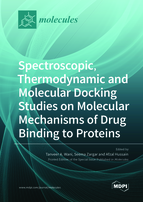Spectroscopic, Thermodynamic and Molecular Docking Studies on Molecular Mechanisms of Drug Binding to Proteins
A special issue of Molecules (ISSN 1420-3049). This special issue belongs to the section "Photochemistry".
Deadline for manuscript submissions: closed (31 May 2022) | Viewed by 29815
Special Issue Editors
Interests: binding interaction; protein-ligand interaction; transport protein; fluorescence quenching; molecular docking; molecular dynamic simulation
Special Issues, Collections and Topics in MDPI journals
Interests: cancer; expression profiling; oxidative stress; molecular docking; plasma protein; binding
Special Issues, Collections and Topics in MDPI journals
Interests: drug development; chromatographic techniques; bioanalytical; novel synthesis of drug
Special Issues, Collections and Topics in MDPI journals
Special Issue Information
Dear Colleagues,
Biological macromolecules interact with each other or ligands to form complexes. Quantifying the binding of chemical entities to a protein is an important early screening step during drug discovery and is of fundamental interest for estimating safety margins during drug development. Since recognition of their importance at the beginning of the 20th century, investigations into binding parameters have received significant attention. Spectroscopy has emerged as an invaluable tool for such studies, proving to be more efficient and cost-effective. A detailed understanding of protein–ligand interactions is therefore central to understanding biology at a molecular level. Moreover, knowledge of the mechanisms responsible for protein–ligand recognition and binding will also facilitate the discovery, design, and development of drugs. Current progress in experimental and computational methods for identifying and characterizing ligand binding sites on protein targets has provided biological insights that are significant for drug discovery.
It is a pleasure to invite you to contribute to this Special Issue of Molecules entitled “Spectroscopic, Thermodynamic and Molecular Docking Studies on Molecular Mechanisms of Drug Binding to Proteins”, which will cover the latest research applications in the field. We aim to collect contributions in the form of original research articles and review articles to add new insights into the role of spectroscopic, thermodynamic and molecular docking studies in drug–protein interactions in biological processes.
Prof. Dr. Tanveer A. Wani
Prof. Dr. Seema Zargar
Dr. Afzal Hussain
Guest Editors
Manuscript Submission Information
Manuscripts should be submitted online at www.mdpi.com by registering and logging in to this website. Once you are registered, click here to go to the submission form. Manuscripts can be submitted until the deadline. All submissions that pass pre-check are peer-reviewed. Accepted papers will be published continuously in the journal (as soon as accepted) and will be listed together on the special issue website. Research articles, review articles as well as short communications are invited. For planned papers, a title and short abstract (about 100 words) can be sent to the Editorial Office for announcement on this website.
Submitted manuscripts should not have been published previously, nor be under consideration for publication elsewhere (except conference proceedings papers). All manuscripts are thoroughly refereed through a single-blind peer-review process. A guide for authors and other relevant information for submission of manuscripts is available on the Instructions for Authors page. Molecules is an international peer-reviewed open access semimonthly journal published by MDPI.
Please visit the Instructions for Authors page before submitting a manuscript. The Article Processing Charge (APC) for publication in this open access journal is 2700 CHF (Swiss Francs). Submitted papers should be well formatted and use good English. Authors may use MDPI's English editing service prior to publication or during author revisions.
Keywords
- binding interaction
- protein–ligand interaction
- transport protein
- fluorescence quenching
- molecular docking
- molecular dynamic simulation







